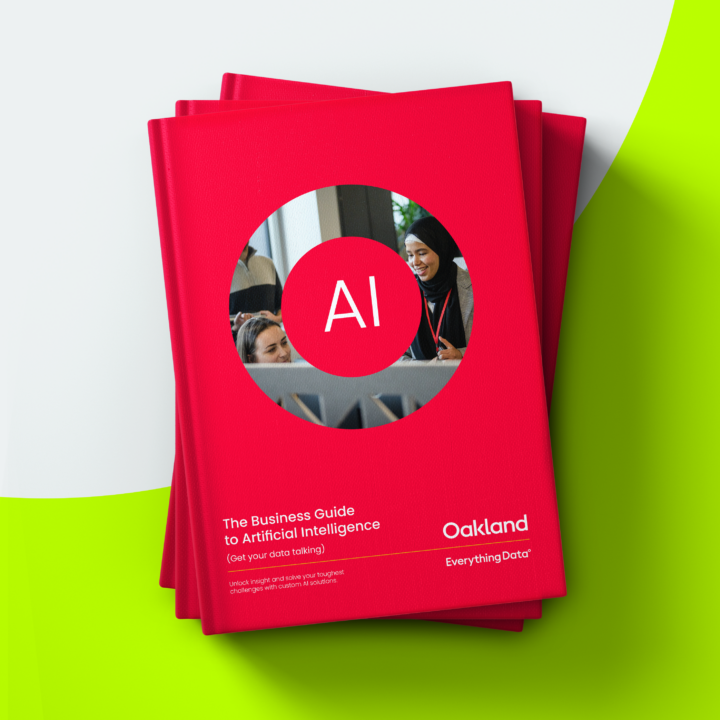Introduction
AI is everywhere these days. It’s organising your emails, checking your spelling, and touching up your photos. At this point, even your Granny has had a go with ChatGPT.
But here’s the thing. How much influence is AI having on the ‘make or break’ moments at your company? For lots of organisations we speak to, the answer is still ‘not much’.
Which is strange, because the commercial opportunity is huge. Gartner estimate that 90% of all enterprise data is unstructured and held in formats like free text, audio files or pictures. Until recently, that unstructured data has been locked away behind barriers of cost and effort. But thanks to recent advances in AI, it’s all suddenly in play. Just imagine the transformative insights on offer if you can get that unstructured data talking.
Of course, if it was easy, you’d already have done it. Yes, you can easily buy some off-the-shelf tools and quickly create a proof-of-concept chatbot. But where does that get you? In business, you need your AI to do more than just entertain or sound plausible. And, in the current climate, executives want to see ROI, not R&D bills.
So, if you want to unleash the power of AI, you need solutions that can do more. Generic tools or under-prepared models quickly wither in a complex business environment. At the other extreme, nobody will wait five years for a mega transformation to get the business ‘ready for AI’.
To succeed, you need the right mindset. That means building AI solutions that put your business first and work with your complexity. Instead of ‘are we ready for Artificial Intelligence?’, at Oakland we prefer to ask: is your AI ready for you?
We use our innovative intelligent agent framework to build ‘process native’ AI-powered solutions that embrace complexity and are at home in the pace and variety of front-line business processes. With our intelligent agents, you can deploy powerful AI capabilities at the heart of your business with solutions that stick.
Down to earth, hands-on and driven by a love of data-enabled transformation, our solutions have realised radical results for some of the UK’s leading businesses.
We hope this guide leaves you with greater curiosity and clarity about what AI could do for your business and, more importantly, some practical advice to get you started.
As ever, if you wish to explore the art of the possible, we are a discovery call away.
What is AI (and why all the headlines)?
In simple terms, AI involves using algorithms and software to carry out tasks that typically require human intelligence, such as understanding natural language, recognizing patterns in data, and making predictions or decisions based on data.
Artificial intelligence (AI) and machine learning (ML) have been in use for decades. However, recent developments have fuelled accelerating awareness and adoption:
Availability of algorithms
Advances in algorithms allow AI to perform thought-like tasks with greater accuracy, from image and speech recognition to natural language processing and decision-making.
Volume and velocity of data
The digitisation of many aspects of life and business resulted in a huge increase in data availability, providing fuel for AI.
Cloud computing
Has made accessing powerful computing resources and large storage capacities on demand easier and more affordable, lowering the barrier to AI adoption.
Commercial applications (and ROI)
With the advent of commercially affordable and accessible AI services (e.g., ChatGPT, Azure Cognitive Services), the adoption and interest in AI have exploded. Moreover, far more businesses are beginning to showcase tangible gains.
Data and IT transformation
AI is only possible with the right data, strategy and infrastructure. As more leaders have invested in IT modernisation, integrating AI into operations has become a natural progression.
Given our 40 years of data and business transformation expertise, we believe that the last point (data transformation) is one of the most important keys to succeeding with AI. Organisations that experience the fastest and deepest gains from AI have strong foundations across their data landscape, particularly in data infrastructure, operations, analytics and governance.
We hear the hype – but what can AI deliver?
It seems like AI delivers scientific and academic breakthroughs every week, but how does this relate to bottom-line gains in business?
Large language models (LLMs), such as the GPT models from OpenAI. The most hyped being ChatGPT. LLMs represent a massive advance in AI’s ability to process and interpret natural language, which allows them to work with far less structured data, such as free text, and cope with far more ambiguous instructions than previous generations of AI. This breakthrough will revolutionise business operations through AI’s ability to enhance efficiency, productivity, and decision-making processes.
By leveraging AI technologies, businesses can automate repetitive tasks, optimise resource allocation, personalise customer experiences, identify market trends, and make data-driven predictions. These capabilities translate directly into cost savings, increased revenue, and improved customer satisfaction. These bring a competitive edge in the market, driving profitability and business growth.
- Interrogating data or public information sources
- Summarising or extracting meaning from large volumes of information
- Writing or checking code (developer assistance)
- Recognising patterns or objects in texts and images
- Following and maintaining rule based decisioning
- Validation and checking standards
- Chatting in structured contexts (e.g. Q&A, support)
- Digitising or ‘reading’ handwritten/physical documents
The crucial point is that these new AI capabilities mean businesses can offload thinking-based tasks to machines at a scale not previously possible. This opens up powerful new possibilities for increasing productivity or unlocking insights that were previously inaccessible.
The AI opportunity
Large language models (LLMs) services such as ChatGPT are so impressive because they’ve found a way to ingest and interpret the petabytes of information freely available on the internet. User interactions are also surprisingly natural and engaging.
If you’re talking to a (public) LLM, you’re essentially talking to the internet. If what you’re asking for is well documented on the internet, you’ll get a good answer. But (hopefully!) your business’s data is not widely available on the internet. Imagine the huge amount of insight within your business stored in free-form text, videos and images such as:
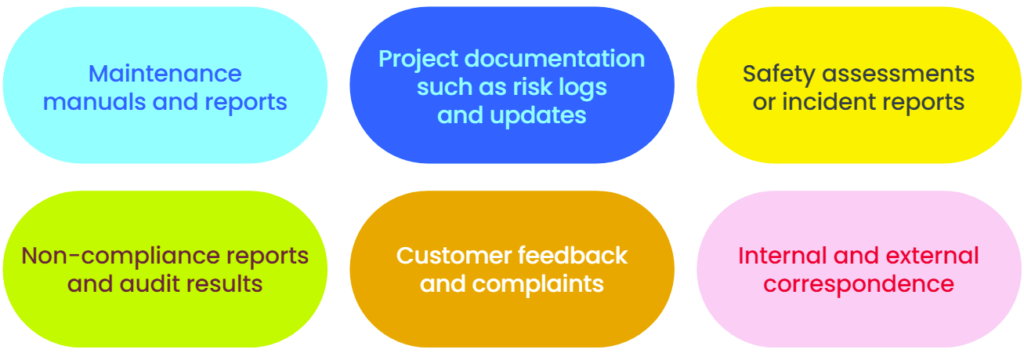
What if you could draw insights from these ‘hidden’ datasets? If that data could talk, what would it say?
This vast data landscape has long been a double-edged sword for businesses—rich in information but daunting in scale and cost to analyse. Critical insights or risks are missed because they are buried in the data.
AI transforms this challenge into an opportunity.
AI represents a revolutionary shift in data handling because it can read, summarise and generate content at a scale unimaginable by human workforces alone. AI enables a revolutionary shift in data handling.
AI offers a cost-effective solution, unlocking insights without the limits of team size or manual processing time. This breakthrough significantly boosts decision-making and learning, transforming how businesses approach their data.
Large language models, a cutting-edge AI subset, are gamechangers. Because of their capability to understand natural language, they grasp and act on ambiguous instructions. This slashes development times and bypassing the exhaustive programming once needed for chatbots.
It’s this leap in productivity and ease of execution that makes AI accessible to non-technical users, sparking innovation and efficiency across every sector.
Case Study:
Leveraging AI and natural language processing for operational insight
Working with Network Rail, Oakland is leveraging Generative AI to revolutionise the way knowledge is managed within the rail industry.
Network Rail, like many enterprise organisations, faced challenges when managing valuable information. There was an opportunity to better leverage data sheld within various document formats such as PowerPoint, Word and PDF as well as in media such as videos and images.
Oakland identified an opportunity to leverage Generative AI to share insights from past projects before and throughout the lifecycle of new projects. This proactive strategy is designed to prevent issues later in the project timeline. They are improving overall efficiency and effectiveness by making the data more accessible.
The project harnesses generative AI capabilities to allow users to interact with the language model through a dynamic chatbot interface. This solution enables users to pose queries and receive tailored responses by drawing from Network Rail’s extensive library of thousands of lessons learned and valuable data sources. Powered by cutting-edge AI algorithms and Azure AI Services, it represents a significant advancement in knowledge management not just in the rail industry but with the potential to be deployed across all sectors.
The proof of concept trap
The buzz around generative AI is undeniable – but so many of the organisations we speak to are still struggling to find impact. Recently Gartner found that nearly half of AI projects fail to meet their goals.
AI projects often spark initial excitement with exciting demos and big promises, but fall short of maintaining engagement and long-term value. The rush to showcase AI’s promise often hits a dead end. Many organisations we speak to become stuck in a frustrating cycle where new proof of concepts are continually put forward but fail to ‘stick’.
Why does this happen? Usually it boils down to one of two reasons (or both).
Over-reliance on off-the-shelf tools
Pre-packaged AI tools are powerful and available at an ever-lower cost. But, they often struggle to cope with the complexity and velocity of enterprise environments. Cracks start to show in one of three main ways:
Relevance: outputs are generic or poorly optimised because the tools underpinning the AI solution don’t understand the context or chosen use case.
Quality: the AI ‘hallucinates’ and produces plausible but false outputs.
Control: proprietary AI services can rapidly become very expensive and pose risks to privacy and security.
Why a chatbot is a good place to start
Chatbots are often the first major step and an easier access point for many businesses to adopt AI and see how information can be made to be much more accessible. The key here though is to build a solution which will add real value and not just be a ‘novelty’. It’s important to do the legwork to integrate Chatbot capabilities with existing processes and workflows and ensure the AI memory is trained on high quality, relevant data. By doing so, the latest AI models can link all your data together and deliver answers in the full context of the dataset. This overcomes the risk of generic answers and enables you to access the mountains of data that is too time-consuming and expensive for humans to interrogate and extract full value from.
Consider these two problems in a human context.
Firstly, you might manage to blag your way through a job interview by reading the internet and giving plausible but generic answers. But you’ll soon be found wanting when it’s time to perform on the job. There are no prizes for being generic. And even if you do know your stuff and take the time to read up on your business, nobody will be happy if you just sit slumped in a chair and refuse to do anything but answer questions.
AI will face all the same problems. In their eagerness to be ‘ready for AI’, we’ve seen businesses push forward with a rapid proof of concept that looks a lot like a chatbot built with off-the-shelf tools.
But once that project is deployed, one of two things quickly happens:
All solutions are isolated and fail to impact core processes because they cannot integrate with complex processes.
Outcome: Low take up and stranded investment

End process are ‘bent out of shape’ to accommodate AI solutions which are inflexible or not adapted to the context.
Outcome: Process friction and wasted effort.

Often, failure causes further frustration and repetition of the original mistake.
The emergence of a ‘PoC trap’ sees proofs of concept frequently proposed but failing to impress for further investment, swiftly leading to a cycle of frustration and disillusionment.
AI solutions that stick
At Oakland, we know that AI’s appeal goes beyond novelty; it’s about real-world application and growth.
Don’t get us wrong, a proof of concept is often a good start (if you get it right), but AI must blend seamlessly with your team and operations to make a mark. This means that the AI you build must be able to cope with your business. All the velocity, complexity and technical debt within your processes won’t disappear just because we’ve made advances in AI.
We’ve already seen what happens if you bend things out of shape to accommodate under-prepared AI solutions. So if you want to get value from AI any time soon, the question you must ask is:
Is AI ready for YOU?
If you want to build AI solutions that are at home in the pace and complexity of a complex enterprise, we’ve found that these three principles are key:

Contextual
Is your AI designed with your unique business context at the forefront? Has it been taught about the environment it’s operating in and the preferences of users?
Without aligning AI to specific business needs (use cases) and ensuring it addresses those effectively, you risk getting caught in the proof of concept (PoC) trap.

Process native
AI solutions should be more than just add-ons; they should feel
intrinsic to your business workflows and decision-making chains.
AI should be envisioned as a natural component of your operations,
capable of navigating and enhancing complex processes. This
requires careful model training and task orientation.

Multi-tooled
‘A chat with the AI’ won’t cut it for the multifaceted challenges of a complex enterprise.
Just as your employees draw on a diverse skill set, effective AI must be multi-functional. A one-trick AI that only manages Q&A sessions will soon be overlooked.
For lasting engagement, AI should adopt a versatile toolset that mirrors the broad capabilities of your workforce.
Fortunately, Oakland has developed an AI approach that embodies these three core principles, making the implementation as practical as it is promising.
Our intelligent agent solutions
Intelligent agents are AI-powered computer programs that comprehend language like humans (via natural language capabilities) but also have powerful tools, careful task orientation and context awareness. The easiest way to think of them is as virtual workers that are highly scalable.
This allows intelligent agents to plan and execute tasks, even in messy complex environments. Just like we do every day at work.
Remember our comparison between a chatbot and a brain in a jar? Well, intelligent agents take that brain and give it the tools and influence to do real work. This allows them to seamlessly integrate into your business processes, undertaking critical, thought-based tasks without disrupting workflows. In other words, intelligent agents underpin process native AI solutions.
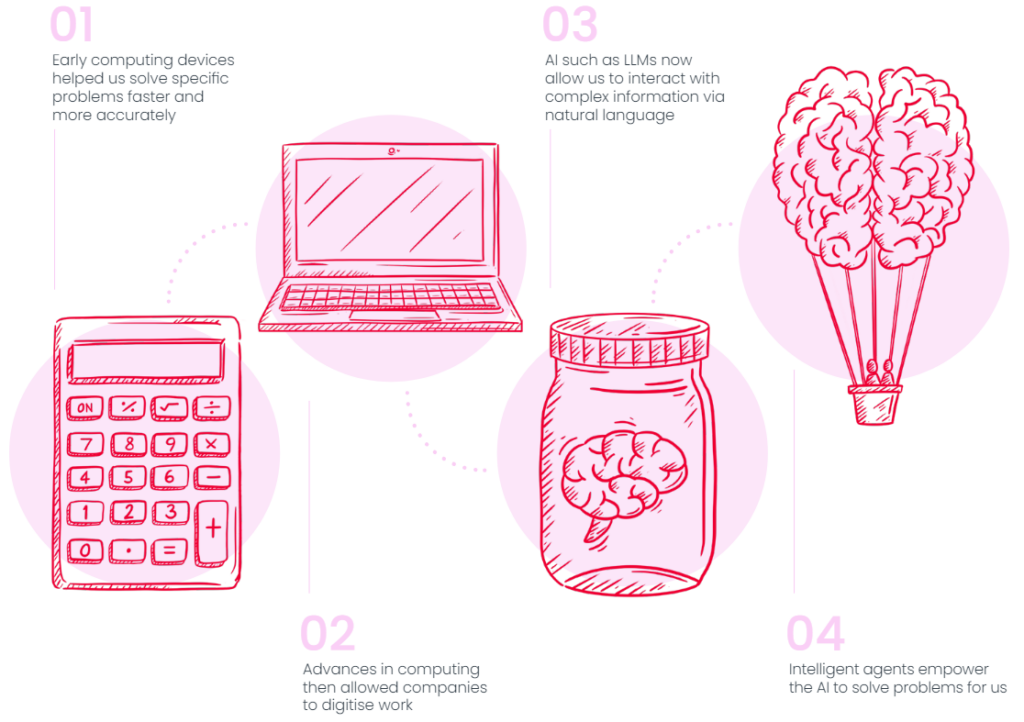
The diagram below shows a simple comparison between a custom chatbot implementation (i.e. LLM trained on internal business data) and an intelligent agent:
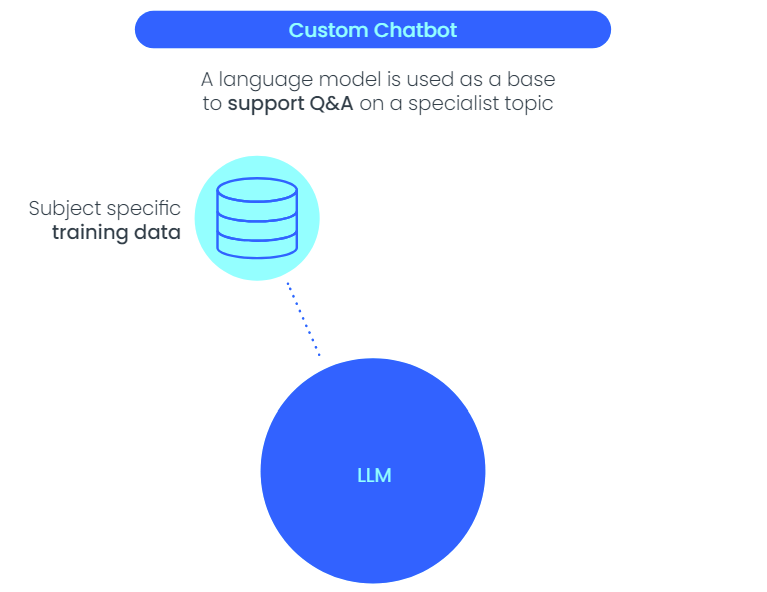
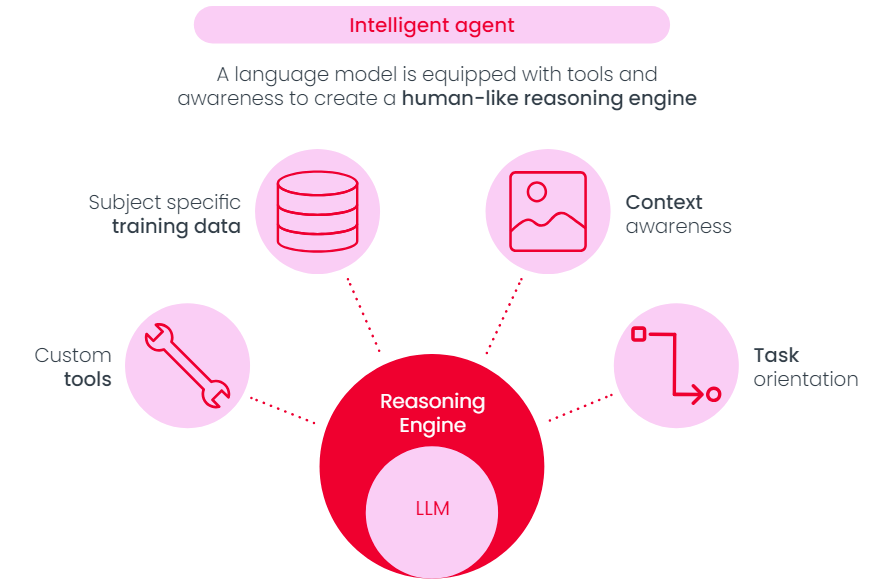
You can see that both the custom chatbot and the intelligent agent have a large language model at their heart, enabling them to understand natural language. But the intelligent agent also has tools, task orientation and context awareness. These additional attributes come together to create a powerful ‘reasoning engine’ with a large language model at its core. These reasoning abilities allow the intelligent agent to understand and plan complex tasks and, critically, take action.
Take a look at the diagram below. It shows the difference in capability between a chatbot and an intelligent agent:

Intelligent agents leverage the latest breakthroughs in natural language processing to understand, plan and execute complex tasks in a human-like way. This means you can offload real work to them. In other words, intelligent agents take AI to your problems.
Acting like virtual workers (not a brain in a jar!), intelligent agents allow you to build AI-powered solutions for important tasks within or alongside your existing processes.
Why do we recommend the ‘intelligent agent’ approach?
The Oakland intelligent agent framework allows you to adopt AI solutions with powerful advantages over both off-the-shelf tooling and ‘start from scratch’ development:
Capability
Intelligent agents boost AI capabilities by tailoring LLM with specific tools and training.
The project risk analyst agent goes beyond mere Q&A, mirroring a proficient human analyst in identifying stakeholders, disseminating insights, and monitoring engagement.
It seamlessly integrates with your workflow, enhancing processes from within, not disrupting them, ensuring a natural fit.
Flexibility and scalability
We build intelligent agents via proprietary managed services, open-source technologies or a hybrid of both.
This flexibility allows a high degree of customisation during development and far more control of costs.
Ease of adoption
The project analyst agent has taken AI capabilities and applied them to the problems where they occur.
It works with the existing data and systems of the host business, and users are not required to take time-consuming detours from their roles to benefit from the solution’s insights.
Speed and simplicity
Speed and simplicity: Our Oakland intelligent agent framework provides pre-built tools, enabling quick customisation for specific use cases.
Intelligent agents offer modular, adaptable, and swiftly deployable solutions, a feat unachievable with current off-the-shelf solutions.
Targeted context
Intelligent agents are trained and tuned to work on a specific problem in a specific place.
Instead of generic commentary on hypothetical questions, they produce detailed, relevant insights and, crucially, actions.
Security and compliance
No data leaves the business or is pushed into public-facing AI models.
Our AI agents are also benchmarked against industry standards such as CIS, ISO 27001 and we have years of experience working with security teams to balance a high level of security and access in new AI initiatives.
Intelligent agent use case: Project risk analytics
The easiest way to see the power of intelligent agents is through a real world example. Here’s a problem statement abstracted from a real Oakland client scenario:
Problem
A major infrastructure company aims to cut project incidents and overruns. The financial stakes are severe, with high-profile projects hitting tens of millions in budget. Despite having thousands of documents on risk logs and past learnings, the sheer volume makes it impractical for staff to sift through. So the same mistakes are made repeatedly.
Opportunity
If the PMO team can harness lessons from past projects, alerting managers to key insights and tracking learnings, they could prevent incidents and delays, potentially saving tens of millions annually.
Complication
Project documents could be quickly fed into a custom chatbot with an interface for project managers to use. But this relies on users having the time to engage and knowing the right questions to ask. There’s no way of linking insights to the audience and this solution would be entirely reliant on proactive behaviour from extremely time-poor users. Whilst this might be a good proof of concept solution to show there is value on offer, it would quickly become isolated.
Intelligent agent solution
An intelligent agent is trained as a ‘project analyst’ and configured to interpret the free text project documentation, interrogate supporting data, and proactively summarise the insights for relevant users. You can see the activities and ‘thought process’ of the agent in the following diagram:
The agent’s toolkit, training and internal design allow it to act as a dynamic feedback analyst and carry out a range of research, monitoring and communication
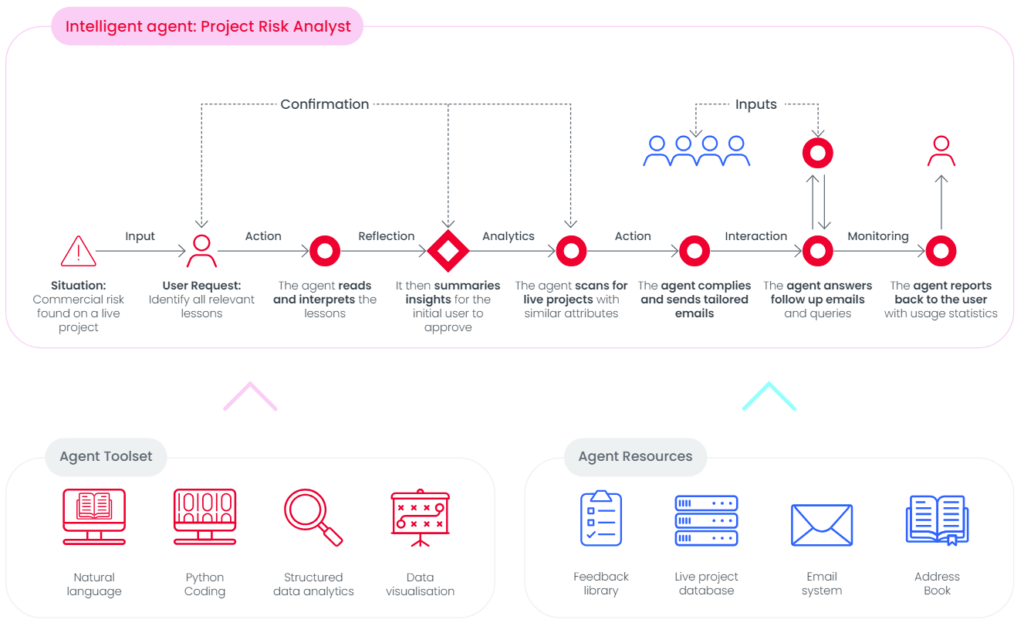
The project risk analyst agent is doing so much more than generic Q&A. It’s doing the good though slightly repetitive work a human analyst would do – identifying stakeholders, sharing its findings and monitoring uptake.
And this is just the start of what an intelligent agent could do. You could extend its capabilities even further, for example by:
- Having the agent populate key project risk factors against live projects in a structured data set that could underpin predictive analytics.
- Embedding an interface to the agent in front-line device applications to allow engineering teams to query the knowledge store in real-time whilst on-site.
- Creating resource optimisation capabilities within the agent to allow it to identify project team composition for current or future projects based on its understanding of risk.
Whilst the project analyst agent example shows the power of intelligent agents, it’s only one in a huge array of possible agents that could be built.
AI could be your answer wherever you require repeatable ‘thinking’ tasks (e.g. reading, summarising, predicting).
If you’re not sure where to start, ask the following questions:
- What’s the biggest problem facing your CEO right now? What are the key barriers to solving it?
- Imagine if the key roles in your company, such as sales or customer service, had a personal assistant. What tasks would they delegate?
- If you had access to unlimited temporary workers, which high priority time-consuming tasks would you assign to them?
- Which of your current business activities generate large volumes of free text entries such as feedback forms, non-compliance reports or job records?
- Where does your business spend time on documents, creating, reading, or checking them?
There’s no point in having a strong development approach if you focus on the wrong use cases. You must demonstrate value and relevance to get your organisation excited and willing to invest in AI.
The right use cases bring the potential of AI to life. Here are some other examples
we’re working on with clients, right now:
Asset historian
Our client has free text asset records dispersed across multiple systems, meaning engineers cannot quickly understand asset history to diagnose issues.
An AI-powered ‘Asset Historian’ agent reads and summarises asset records and interrogates supporting data to quickly provide a single, 360 degree view of the asset and respond dynamically to engineer requests.
Resource scheduler
Our client is struggling to align front-line resources to demand because their skills are stored in free text CVs or training files.
An intelligent agent reads CVs, creates and populates a skills matrix and then uses that data to dynamically optimise task allocation within existing work management systems.
Alert triage
An engineering control room receives so many alerts from asset-based telemetry that they are overwhelmed and unable to effectively identify when serious incidents are occurring.
An intelligent agent uses control room policies, asset history and alarm description analytics to read and filter telemetry alerts for control engineers.
Data science co-bot
Our client’s data science team were spending a high proportion of their time on repetitive data manipulation and lowlevel workflow management. This workload prevented them from working on new, value-adding projects.
A series of intelligent agents are built to work alongside the data science team, creating and executing code to perform ad hoc data preparation, mastering and low-level task management under the supervision of the data scientists.
Need help getting started with AI?
Oakland runs a complementary AI discovery workshop to help you understand the possibilities of AI, analyse the challenges facing your business, and discover future use cases.
Find out more details and register your interest here
Your journey with AI
AI has the potential to change everything about the way we work. How can you make sure your company is ready to thrive in the world of AI? What do you need to build? If you’re not careful this can quickly enter mind-boggling territory.
We like to keep it simple and talk about the ‘3 Ps’:
Purpose
Many businesses find it hard to connect commercial goals with AI’s potential.
After launching your first AI solutions and gaining momentum, it’s crucial to present a clear vision for future success quickly.
A value-driven data and AI strategy can harmonise AI initiatives with broader activities, aligning your entire organisation with unified, business-focused objectives, and a compelling vision for adoption.
We’ve refined a practical, effective approach to applying a data and AI strategy that positions AI as central to your organisation’s future.
Platform
Everyone will have access to powerful algorithms and cloud capabilities. The winners will be those who can deploy AI-powered solutions the fastest to meet their specific needs.
This hinges on making the right data swiftly available to your models.
Research indicates that 45% of the time spent on AI/ML projects is dedicated to data preparation, highlighting the high costs associated with scattered or unrefined data.
A robust data platform is vital for AI success because the ‘garbage in, garbage out’ rule still applies.
Excitingly, AI can transform your data platform, enhancing efficiency and ease of maintenance through automated code generation and documentation.
With AI-driven performance tuning and natural language data exploration, the “intelligent data platform” concept emerges. This approach optimises operations and sets the stage for future innovations.
People
Data is crucial for any modern business; neglecting your data means risking the effectiveness of your AI.
Adopting AI successfully requires a whole-organisation approach, focusing as much on people, culture, and governance as it does on technology.
While AI presents exciting opportunities, it also carries risks. Poor governance can lead to ethical and privacy issues, potentially harming finances, trust, and reputation, regardless of size.
To thrive with AI, it’s essential to establish the right controls and foster a supportive culture. Winning the support of your team and educating them carefully is critical.
The following are particularly important:
- Governance: Create and apply a data and AI governance framework to ensure control and ownership when adopting AI.
- Awareness: Increase awareness and educate employees on AI’s capabilities, opportunities, and risks.
- Literacy: Enhance AI understanding and skills among key employee groups.
Take the next step with our AI discovery workshop
The approaches outlined in this guide are not futuristic ideas or academic concepts; they’ve already been proven and deployed within production environments.
If you would like to explore what’s possible with AI in your organisation, why not book a (free) AI discovery workshop?
During the workshop, we’ll explore your current challenges and draw on our extensive AI, business process and data expertise to help you explore the art of the possible.
Here are some of the areas we typically cover:
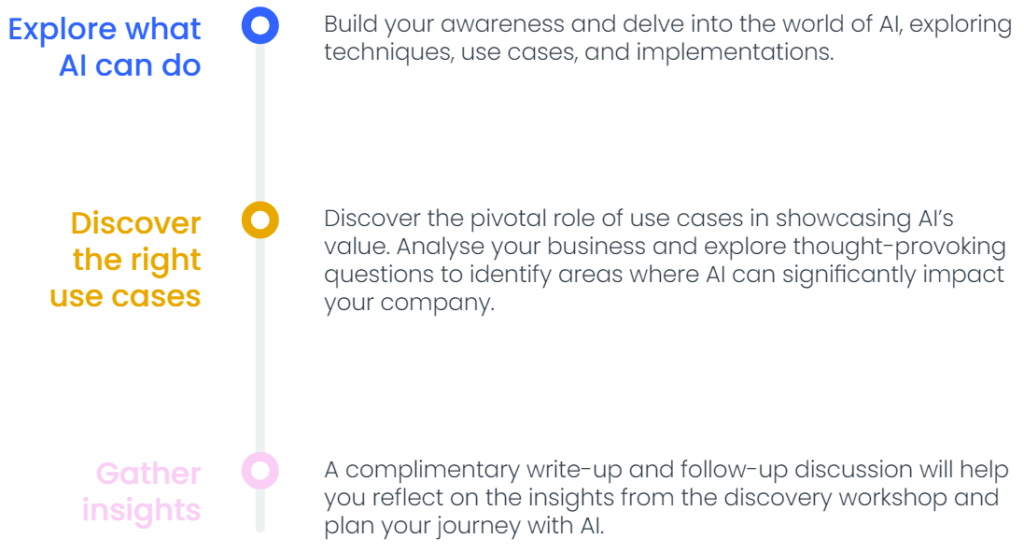
Register to learn more and reserve your AI discovery workshop, or book a call with one of our lead AI consultants here
Our services
Oakland has 40 years of hard-won experience in complex process improvement and data-enabled transformation.
We offer a range of customisable services. You can choose to engage us at specific points, or we can partner with you throughout your AI adoption journey:
AI accelerator
If you’re looking to take your first steps with AI, you need to deliver impact quickly to build momentum. Using our ‘Lighthouse Project’ approach we can rapidly deploy and configure AI-powered solutions from powerful blueprints and prebuilt tools within our intelligent agent framework. Within weeks, we can build you a prototype solution that demonstrates AI capabilities in action in a way that is customised to your business.
Bespoke AI solution development
Leveraging our intelligent agent framework and deep AI engineering capabilities, we can design, build, deploy and support customised AI-powered solutions that seamlessly integrate into your business processes and deliver lasting value. These can be standalone or enhancements to your existing AI solutions.
AI transformation partnering
Enterprise adoption of AI is a challenge that cuts across people, processes and technology. We meet you wherever you are on your AI journey, get under the skin of your challenge, and stick right by your side as your hands-on, all-in partner at every stage. As a full-service data and AI consultancy, we have the expertise to support you with every aspect of your transformation.

